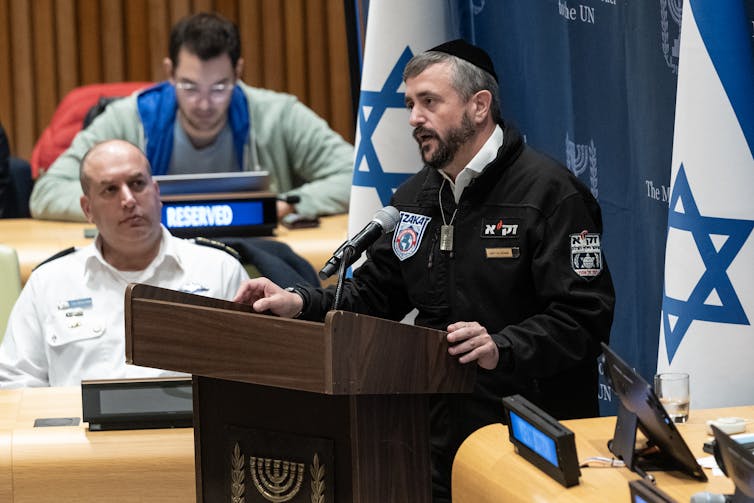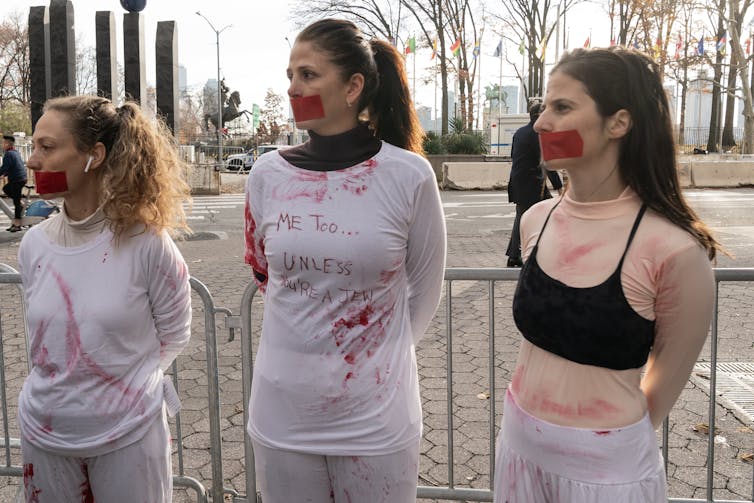Two United Nations human rights experts said on Jan. 8, 2024, that there was growing evidence of Hamas’ use of sexual violence against people on Oct. 7, 2023 – and that the attacks on civilians likely amount to crimes against humanity.
“As armed Palestinian groups rampaged through communities in Israel bordering the Gaza strip, thousands of people were subjected to targeted and brutal attacks, the vast majority of whom were civilians,” Alice Jill Edwards, an independent expert on torture, and Morris Tidball-Binz, an expert on extrajudicial, summary or arbitrary executions, said in a statement. “The growing body of evidence about reported sexual violence is particularly harrowing.”
The United Nations, women’s groups and human rights groups previously faced criticism for not quickly condemning Hamas fighters for raping and sexually violating Israelis during the Oct. 7, 2023, attack.
Most critics cite rising antisemitism as the reason some experts and advocates did not quickly rally behind Israel’s repeated claims that Hamas fighters committed sexual violence.
There is strong evidence that Hamas committed sexual violence, including eyewitnesses’ and first responders’ testimony, medical assessments of released hostages and independent investigations from media outlets such as The New York Times. This includes rape, gang rape, sexual torture and sexual mutilation of Israelis of diverse genders and ages.
Beyond antisemitism, were there other reasons for the initial hesitation to identify sexual violence as part of Hamas’ attack?
We are scholars who work directly with victims of war-related sexual violence and other serious crimes.
We believe that some experts may have hesitated because Hamas hasn’t been known in the past to use sexual violence in its attacks against Israeli civilians. We take this factor into consideration as we suggest why Hamas may have made a decision to use sexual violence during the Oct. 7 attack.

Sexual violence in war
Research on sexual violence in armed conflicts has grown rapidly over the past 15 years, as feminist scholars increasingly took women’s and girls’ experiences of war seriously.
This research helps explain what motivates people, governments and armed groups to fight wars. It also helps illuminate, among other things, why some armed forces and groups commit sexual violence during wars and how to prevent and address such violence.
Armed forces and armed groups sometimes intentionally use sexual violence to carry out attacks and achieve military goals, leading to the term “rape as a weapon of war.”
Rape can be used to terrorize and brutalize civilians of the opposing side and to destroy the morale and fighting spirit of enemy forces. In a number of recent conflicts, rape has been a potent weapon to motivate populations to flee instead of fighting back.
Sexual violence has been most recently used against civilians in wars in Ethiopia, Ukraine and Darfur.
Sexual violence’s effects on victims, their families and their communities include serious short- and long-term, physical, psychological, social and economic harm.
When and where it tends to happen
One of the best publicly available datasets on sexual violence in war is the Sexual Violence in Armed Conflict data project.
Created by professor Dara Kay Cohen and housed at Harvard University’s Kennedy School of Government, this public data project analyzes rape, sexual slavery, forced prostitution, sexual torture and other sexual crimes in 189 armed conflicts in 86 countries, from 1989 through 2021.
Our analysis of this data shows that, first, sexual violence does not occur in all conflicts. Sexual violence was reported in approximately half of the 189 armed conflicts.
Second, sexual violence may be used by some, but not all, groups fighting in a conflict. It also does not happen consistently throughout a conflict.
Third, government forces are twice as likely as rebel and insurgent groups to use sexual violence, with government forces committing sexual violence in 28% of the years of conflict versus rebel groups doing so in 14% of years of conflict.
For example, the armies of Myanmar, Russia and Syria are notorious for their use of sexual violence against civilians.
Finally, although rebel groups are less likely to use sexual violence, when they do they are significantly more likely to use systematic and widespread sexual violence, as opposed to isolated occurrences.
The case of Israel and Palestinian territories
Previous research overwhelmingly finds that after 1948, the conflict between Israel and Palestinian groups has very low levels of reported sexual violence committed by either the Israeli military or Hamas, which formed in 1987. Some scholars question these findings.
There are credible reports of Israeli security forces sexually torturing Palestinians in eight of the 31 years between 1989 to 2021 and also raping Palestinians during this time frame. These acts of sexual torture and rape are found in infrequent and isolated reports, and most occurred when Palestinians were detained.
Hamas’ international law violations, including using human shields, taking hostages and killing civilians, are well documented.
Our analysis shows that Hamas does not have a history of using sexual violence against Israelis.

The intent of Hamas’ attack
Given this history, how do we make sense of the many reports now emerging ofHamas’ use of sexual violence in the Oct. 7 attack?
Researchers have determined that much of the sexual violence during armed conflict is men communicating their own masculinity to others, while demonstrating other males’ inability to protect women and girls or defend themselves.
Male perpetrators also use sexual violence to demonstrate their power over women, girls, men and boys, as well as over their victims’ families and, symbolically, over the larger community or country they are fighting against.
Female and male victims of sexual violence can experience a range of physical and psychological harms, some of which can last a lifetime. They may experience stigmatization, discrimination and rejection by their families and communities, which can cause long-lasting social and economic harm. Female victims can become pregnant. Some in such cases will terminate their pregnancies, while others give birth to children as a result of their rape.
Hamas sexually brutalized the women and men they raped, with reports that murdered women’s genitalia and breasts were severely mutilated. Hamas also reportedly shot and killed women either while or after they raped them on Oct. 7.
These violent acts suggest an intent to utterly destroy their victims, while also terrorizing the Israeli public and humiliating Israeli men, Israel’s military and the state of Israel.
We also think that Hamas’ use of sexual violence was intended to outrage and provoke Israel to engage in a permanent state of war with Hamas and attack civilian spaces in Gaza. Hamas hopes in doing so to consolidate power and keep the Palestinian crisis alive.
Was Hamas’ use of sexual violence part of a predetermined strategy or fighters acting opportunistically without orders? At least a year in advance, Hamas mapped and planned the attack with painstaking detail.
They also carried out an intense daylong exercise that mimicked the actual Oct. 7 attack. Given this level of planning and Hamas’ previous lack of using sexual violence, it is highly unlikely that Hamas’ sexual violence committed against Israelis was the result of some men who went rogue. More likely, sexual violence was part of Hamas’ war tactics and strategy.
The United Nations and the International Criminal Court are now, rightly, investigating Hamas’ use of sexual violence as possible war crimes and crimes against humanity.
Under international law, surviving victims have a right to justice and a range of assistance to aid in their recovery. Families of the victims who were killed have a right to information about what happened to their loved ones. Throughout it all, everyone directly affected by sexual violence has a right to be treated with care and dignity.
This article, originally published on Dec. 11, 2023, was updated on Jan. 11, 2024, to reflect news about the United Nations’ statement.

